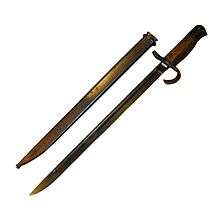Jūkendō
 Japanese Type 30 bayonet (1894–1945) | |
| Focus | Weaponry (Bayonet) |
|---|---|
| Hardness | Competitive |
| Country of origin | Japan |
| Creator | No single creator |
| Parenthood | Historical |
| Olympic sport | No |
Jūkendō (銃剣道) is the Japanese martial art of bayonet fighting,[1][2][3][4] and has been likened to kendo (but with bayonets instead of swords).[5]
According to Tanaka Fumon, Jukendo techniques are based on sojutsu (spear fighting)[6] or bayonet techniques from the 17th century, when firearms from Portugal were introduced to Japan.[7] However, according to Jukendo french researcher Baptiste Tavernier, Jukendo techniques are mostly based on the teachings and influence of the French military missions to Japan at the beginning of the Meiji era.[8]
During the Meiji period, Japanese bayonet fighting techniques were consolidated into a system named jukenjutsu,[7] and taught at the Toyama military academy in Tokyo.[7] Morihei Ueshiba, founder of Aikido, trained in jukenjutsu and incorporated some of this art tactics into his own interpretation of the use of the wooden staff or Jō.[9] Following World War II, the practice of jukenjutsu was banned by the Allies, but it later returned in the modern form of jukendo.[7] The Japan Amateur Jukendo Federation was established in 1952.[10] The All Japan Jukendo Federation was established in April 1956.[11]
In response to a request from the 30,000 member All-Japan Jukendo Federation, in April 2017 the Japanese government added Jukendo to the list of nine approved martial arts for Japanese junior high schools. As of 2017 only one school had taken it up.[12][13][14][15][16][17]
Modern jūkendō uses a mokujū, a wooden replica of a rifle with an attached and blunted bayonet at the end, in place of an actual rifle.[5] The art is practised by both Japanese military personnel and civilians.[7] Training incorporates kata (patterns), two-person drills, and competitive matches using mokujū and protective armor.[7] The three main target areas are the heart, throat, and lower left side of the opponent.[7]
See also
References
- ↑ Stevens, J. (1985): "The Founder, Ueshiba Morihei." In R. Strozzi-Heckler (Ed.): Aikido and the new warrior (pp. 5–22). Berkeley, CA: North Atlantic. ( ISBN 978-0-9381-9051-6)
- ↑ Mather, J. (1990): "A Sensei's story: Karate's Takayuki Kubota." Black Belt, 28(6):40–44.
- ↑ Steele, D. E. (1991): "Training to fight Saddam's army: US troops prepared for hand-to-hand combat against Iraqis." Black Belt, 29(5):33–36.
- ↑ Lowry, D. (2009): The Karate way: Discovering the spirit of practice (p. 76). Boston, MA: Shambhala. ( ISBN 978-1-5903-0647-5)
- 1 2 Clayton, B. D., Horwitz, R., & Pollard, E. (2004): Shotokan's secret: The hidden truth behind Karate's fighting origins (p. 148). Black Belt Books. ( ISBN 978-0-8975-0144-6)
- ↑ Tanaka, F. (2003): Samurai fighting arts: The spirit and the practice (p. 222). Tokyo: Kodansha International. ( ISBN 978-4-7700-2898-3)
- 1 2 3 4 5 6 7 Fighting Arts: Jukendo (c. 2008). Retrieved on February 28, 2010.
- ↑ Seido - Budo Equipment & Practice in Japan (2018-03-01), [Interview] Baptiste Tavernier - Jukendo, Budo & The Relevance of Martial Arts Today (Part 2/2), retrieved 2018-05-03
- ↑ de Jong, H. (c. 2007): Aikido Archived 2013-10-20 at the Wayback Machine. Retrieved on February 28, 2010.
- ↑ Wagner, E. A. (1989): Sport in Asia and Africa: A comparative handbook (p. 60). New York: Greenwood. ( ISBN 978-0-3132-5767-4)
- ↑ All Japan Jukendo Federation Archived 2011-07-21 at the Wayback Machine. (in Japanese). Retrieved on February 28, 2010.
- ↑ "'Bayonet techniques' to be taught to junior high school students". Shimbun Akahata. April 2, 2017. Retrieved August 8, 2018.
- ↑ "Japan's new education guidelines condemned for adding wartime military training item". Xinhua. April 3, 2017. Retrieved August 8, 2018.
- ↑ Sieg, Linda (April 6, 2017). "Japan education reforms stir memories of wartime indoctrination". Reuters. Retrieved August 8, 2018.
- ↑ Ryall, Julian (April 24, 2017). "Japanese children can now learn 'jukendo' bayonet style fighting at school". South China Morning Post. Retrieved August 8, 2018.
- ↑ Aoki, Mizuho (April 24, 2017). "Prewar bayonetting martial art makes return to schools". Japan Times. Retrieved August 8, 2018.
- ↑ "World War II practice bayonets discovered, evoking memories of Japan's wartime student military training". Japan Times. June 26, 2017. Retrieved August 8, 2018.